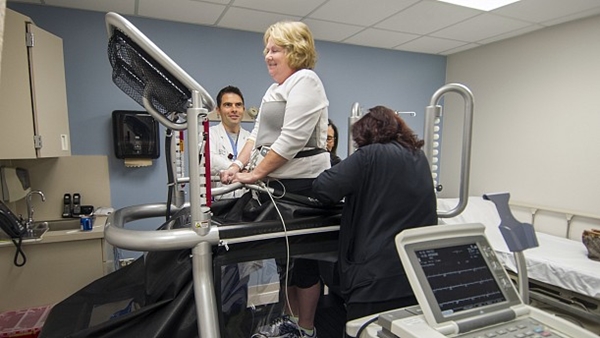1 August 2016. Researchers at University of Cincinnati Medical Center plan to evaluate an anti-gravity treadmill for cardiac stress tests that check for heart disease. The treadmill is made by AlterG Inc. in Fremont, California, and will be tested among individuals with physical conditions that prevent them from using a conventional treadmill.
A cardiac stress test helps reveal symptoms of heart disease, which may not appear in day-to-day life or even in an electrocardiogram, or EKG, in a resting state. After an resting-state EKG, the individual steps on a treadmill, also with EKG leads attached, and walks first slowly and easily, then with increasing speed or incline to increase the heart rate. In cases where the patient cannot exercise, an the drug regadenoson is given to increase heart rate and provide an agent for imaging with a gamma camera for real-time functional scanning.
The anti-gravity treadmill has an air-tight pressurized compartment that supports the individual from the waist down. The compartment is inflated, which suspends a person over the walking surface of the treadmill. By pressurizing the compartment, the weight of the individual on the treadmill is decreased by 25 to 50 percent.
“For those of us who tried it out, the anti-gravity treadmill feels like walking on the moon I suppose,” says internist and radiologist Myron Gerson, in a medical center statement. “The sensation of gravity is much less and we can un-weight the patient by 25 percent, 50 percent or even more.” Gerson is one of the study’s principal investigators.
The clinical trial plans to test the anti-gravity treadmill among some 50 patients with conditions such as knee, foot, or back problems that prevent them from taking a conventional stress test. Participants will be randomly assigned to receive regadenoson or use the anti-gravity treadmill.
Exercise is expected to provide better data than the drug regadenoson. “We are testing two hypotheses,” adds Gerson. “First, is the anti-gravity treadmill safe for these people, and second, can use of the anti-gravity treadmill improve image quality?” Gerson believes improved image quality might be achieved when patients reach target heart rates during their stress tests. Participants in the trial who do not reach target heart rates will instead be given regadenoson.
AlterG first developed the anti-gravity treadmill under contract with NASA to offer astronauts on the International Space Station a way to exercise in a zero-gravity environment. The company now markets a version of the treadmill for rehabilitation clinics. AlterG is donating the treadmill for the trial, which is sponsored by University of Cincinnati.
Read more:
- Device Measuring Nerves on Heart Rhythm in Development
- Study to Evaluate Blood Pressure Diagnostics
- American Heart Assn, Amazon Partner on Cloud Analytics
- App Evaluates Chest Pain Patients for Discharge
- Report from Maker Faire: Wrist Band Takes Blood Pressure
* * *


 RSS - Posts
RSS - Posts
You must be logged in to post a comment.